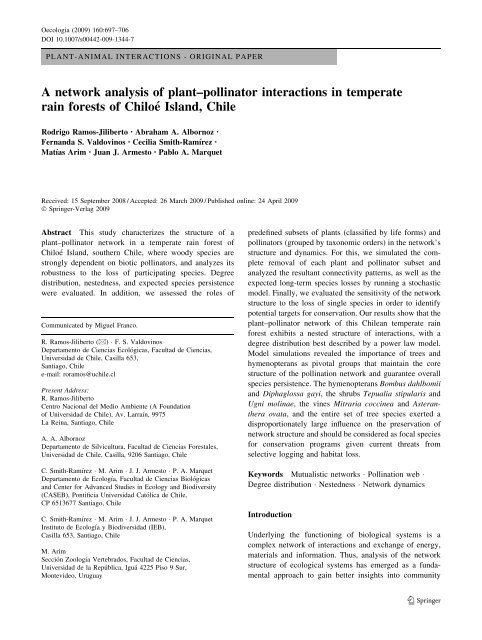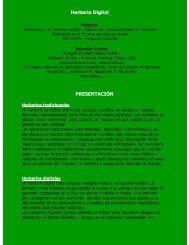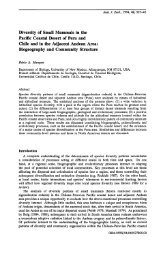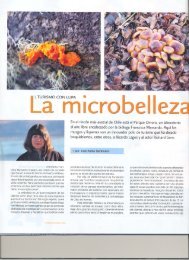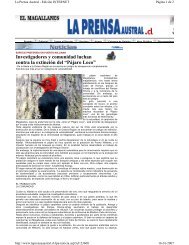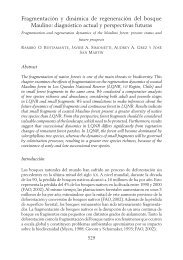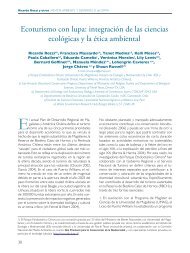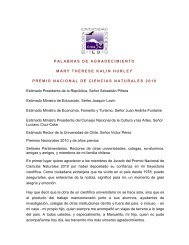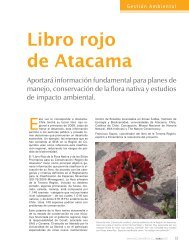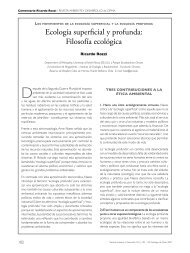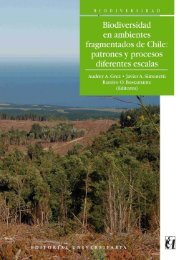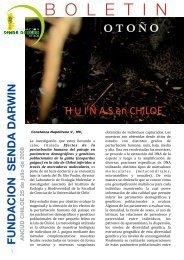A network analysis of plant–pollinator interactions in temperate rain ...
A network analysis of plant–pollinator interactions in temperate rain ...
A network analysis of plant–pollinator interactions in temperate rain ...
Create successful ePaper yourself
Turn your PDF publications into a flip-book with our unique Google optimized e-Paper software.
700 Oecologia (2009) 160:697–706ResultsThe poll<strong>in</strong>ation <strong>network</strong> <strong>in</strong>volved 128 poll<strong>in</strong>ator and 26plant species display<strong>in</strong>g 313 mutualistic <strong><strong>in</strong>teractions</strong>(Table 1). Among the plants there were 11 shrub species,n<strong>in</strong>e tree species, and five v<strong>in</strong>es; <strong>in</strong>sect species weredom<strong>in</strong>ated by 21 hymenopterans, 52 dipterans, and 47coleopterans.abDegree distribution and nestednessThe power law model best described the degree distribution<strong>of</strong> both the whole <strong>network</strong> and the animal subweb,while the exponential model best described the degreedistribution <strong>of</strong> plants (Fig. 1). Nevertheless, rigorouslydiscern<strong>in</strong>g the form <strong>of</strong> a degree distribution by means <strong>of</strong>standard fitt<strong>in</strong>g procedures is problematic due to the limitedrange <strong>of</strong> degree values <strong>in</strong>herent to ecological <strong>network</strong>s.Therefore, the shape <strong>of</strong> degree distributions found shouldbe taken as <strong>in</strong>dicative <strong>of</strong> general trends. On the other handthe <strong>network</strong> presented a significantly nested structure,when compared to the null model (Table 2). A visualrepresentation <strong>of</strong> the nested <strong>network</strong> (Fig. 2) was obta<strong>in</strong>edwith the s<strong>of</strong>tware PAJEK (http://vlado.fmf.uni-lj.si/pub/<strong>network</strong>s/pajek/default.htm).We assessed the role that different plant life forms andorders <strong>of</strong> <strong>in</strong>sects play on the <strong>network</strong> structure by evaluat<strong>in</strong>gboth degree distribution and nestedness <strong>of</strong> the <strong>plant–poll<strong>in</strong>ator</strong> <strong>network</strong> after removal <strong>of</strong> each target group (seeTables 2, 3, 4). No qualitative changes <strong>in</strong> the degree distributionswere observed after the removal <strong>of</strong> v<strong>in</strong>es, trees,or coleopterans. On the other hand, degree distribution <strong>of</strong>the whole <strong>network</strong> changed from power law to truncatedpower law when dipteran poll<strong>in</strong>ators were removed.Degree distribution for forest plants changed from exponentialto power law after remov<strong>in</strong>g flower-visit<strong>in</strong>ghymenopterans. F<strong>in</strong>ally, animals’ degree distributionchanged from power law to exponential when exclud<strong>in</strong>geither shrubs or hymenopterans. Values <strong>of</strong> fitted parametersare shown <strong>in</strong> Table 3.Fig. 1 Cumulative degree distribution <strong>of</strong> the Chiloé ra<strong>in</strong> forestpoll<strong>in</strong>ation <strong>network</strong>. a Whole <strong>network</strong> b plants and c animals. SeeTable 3 for model fitt<strong>in</strong>gRemov<strong>in</strong>g any <strong>of</strong> the target plant or <strong>in</strong>sect poll<strong>in</strong>atorgroups did not elim<strong>in</strong>ate the nestedness <strong>of</strong> the rema<strong>in</strong><strong>in</strong>g<strong>network</strong> (Table 2). Nevertheless quantitative effects onnestedness were detected when shrubs or hymenopteranswere removed. T <strong>of</strong> the <strong>network</strong> without shrubs was significantlyhigher than the temperature <strong>of</strong> matrices whereequal numbers <strong>of</strong> plants were removed at random. Likewise,T <strong>of</strong> the hymenopterans-free <strong>network</strong> was significantlyhigher than that <strong>of</strong> their correspond<strong>in</strong>g null matrices(Table 4). We obta<strong>in</strong>ed the same qualitative results us<strong>in</strong>gthe s<strong>of</strong>tware ANINHADO (Guimarães and Guimarães2006) for calculat<strong>in</strong>g T, suggest<strong>in</strong>g that our results arerobust.cTable 1 Basic statistics <strong>of</strong> thenumber <strong>of</strong> <strong><strong>in</strong>teractions</strong> (degree)with<strong>in</strong> each species subsetNumber <strong>of</strong> species <strong>in</strong>systemMean number<strong>of</strong> <strong><strong>in</strong>teractions</strong>Median M<strong>in</strong>imum MaximumFlower<strong>in</strong>g plantsV<strong>in</strong>es 5 3 2 2 7Shrubs 11 8.55 4 2 47Trees 9 21.89 18 8 38Insect poll<strong>in</strong>atorsHymenopterans 21 4.48 2 1 21Dipterans 52 2.12 1 1 12Coleopterans 47 1.87 1 1 6123
Oecologia (2009) 160:697–706 701Table 2 Basic features <strong>of</strong> the Chiloé poll<strong>in</strong>ation <strong>network</strong> and the subwebs obta<strong>in</strong>ed after removal <strong>of</strong> a given subset <strong>of</strong> speciesAnalyzed <strong>network</strong>Whole V S T H D CPlant species 26 21 15 17 22 24 26Animal species 128 128 105 66 107 76 81Connectivity 0.093 0.110 0.138 0.102 0.092 0.109 0.104Interactions 311 296 217 114 217 199 220Nestedness a 2.80** 4.10** 6.99** 1.54** 3.38** 3.05** 3.50**V V<strong>in</strong>es, S shrubs, T trees, H hymenopterans, D dipterans, C coleopterans** P \ 0.001a Significance <strong>of</strong> nestedness was tested aga<strong>in</strong>st a null model where the probability <strong>of</strong> occurrence <strong>of</strong> an <strong>in</strong>teraction was proportional to the meanconnectivity <strong>of</strong> each plant-animal pairFig. 2 Bipartite graph <strong>of</strong> the Chiloé ra<strong>in</strong> forest poll<strong>in</strong>ation <strong>network</strong> P,arranged to display its nested structure. Plant and animal species arepresented <strong>in</strong> the left and right columns, respectivelyWe then evaluated the role <strong>of</strong> the plant life form and<strong>in</strong>sect order on <strong>network</strong> persistence by project<strong>in</strong>g the metacommunitydynamics <strong>of</strong> the <strong>network</strong> and assess<strong>in</strong>gdynamic ext<strong>in</strong>ction <strong>of</strong> species follow<strong>in</strong>g the removal <strong>of</strong>each target group.The model predicted that the removal <strong>of</strong> trees would<strong>in</strong>crease the fraction <strong>of</strong> plant and animal ext<strong>in</strong>ctions relativeto both the unmanipulated <strong>network</strong> and the null model,with the exception <strong>of</strong> plant ext<strong>in</strong>ctions at an ext<strong>in</strong>ction/colonization ratio k = 0.25 (Fig. 3). On the other hand, theremoval <strong>of</strong> shrubs was predicted to lead to a decrease <strong>in</strong>species ext<strong>in</strong>ctions compared to the correspond<strong>in</strong>g nullmodel, with the only exception <strong>of</strong> poll<strong>in</strong>ator ext<strong>in</strong>ctions atk = 0.25. Note that for k = 0.75, the fraction <strong>of</strong> speciespredicted to go ext<strong>in</strong>ct follow<strong>in</strong>g removal <strong>of</strong> shrubs was notsmaller than that <strong>in</strong> the unmanipulated <strong>network</strong>. The effect<strong>of</strong> v<strong>in</strong>e removal was less clear. At k = 0.75 speciesext<strong>in</strong>ctions were lower than <strong>in</strong> the null model, although thereverse effect resulted (only for plants) at k = 0.5. Nodifferences were observed at k = 0.25.Model results after removal <strong>of</strong> <strong>in</strong>sect groups are shown<strong>in</strong> Fig. 4. Removal <strong>of</strong> hymenopterans largely <strong>in</strong>creasedspecies ext<strong>in</strong>ctions when compared to both the unmanipulated<strong>network</strong> and to random <strong>in</strong>sect removal, except forpoll<strong>in</strong>ators at k=0.25. The removal <strong>of</strong> coleopteransenhanced plant persistence as compared to random removals,and showed no effect on <strong>in</strong>sect species persistence.Delet<strong>in</strong>g dipterans from the <strong>network</strong> exerted no effect,relative to random deletion, for k = 0.75. On the otherhand, for k=0.25 and k = 0.5 the effect was <strong>in</strong>versebetween plants and animals (see details <strong>in</strong> Fig. 4).To identify species <strong>of</strong> ra<strong>in</strong> forest mutualists that may be<strong>of</strong> conservation concern, we evaluated the contribution <strong>of</strong>each species to the topological shifts driven by experimentalremovals. We measured nestedness (<strong>network</strong> temperature)and the exponent <strong>of</strong> the power law model fitted tothe degree distribution <strong>of</strong> the <strong>network</strong> after s<strong>in</strong>gle speciesdeletions (Fig. 5). Among plants, the removal <strong>of</strong> the v<strong>in</strong>esMitraria cocc<strong>in</strong>ea and Asteranthera ovata (Gesneriaceae)markedly decreased <strong>network</strong> nestedness. On the otherhand, the decrease <strong>in</strong> nestedness caused by the removal <strong>of</strong>shrubs (Table 4) was largely expla<strong>in</strong>ed by the removal <strong>of</strong>the supergeneralist Tepualia stipularis (Myrtaceae), followedby Ugni mol<strong>in</strong>ae (Myrtaceae) (Fig. 5, left). Conversely,the removal <strong>of</strong> the tree species Myrceugeniaplanipes, Myrceugenia ovata, and Amomyrtus meli (allMyrtaceae) exerted the largest effect towards decreas<strong>in</strong>gT. Among <strong>in</strong>sects, the decrease <strong>in</strong> <strong>network</strong> nestednesscaused by the removal <strong>of</strong> hymenopterans seems to be agroup effect, not fully expla<strong>in</strong>ed by the loss <strong>of</strong> <strong>in</strong>dividualspecies, although the removal <strong>of</strong> Diphaglossa gayi exerted123
702 Oecologia (2009) 160:697–706Table 3 Model selection fordegree distribution P(K) <strong>of</strong> thewhole web <strong>of</strong> <strong><strong>in</strong>teractions</strong>, andthose <strong>of</strong> the plants and animalpoll<strong>in</strong>ators separatelyCI Confidence <strong>in</strong>terval, EXexponential model PK ð Þe aK ,PL power law modelPK ð ÞK c , TPL truncatedpower law modelPK ð ÞK c e K=Kc , a fittedconstant, c fitted constanta The best model was selectedaccord<strong>in</strong>g to the correctedAkaike’s <strong>in</strong>formation criterionBest model a Parameter values (±95% CI) Expla<strong>in</strong>ed varianceObserved <strong>network</strong>Whole PL c = 0.999 (0.033) 0.990Plants EX a = 0.088 (0.010) 0.952Animals PL c = 1.275 (0.090) 0.993V<strong>in</strong>es removedWhole PL c = 1.015 (0.032) 0.996Plants EX a = 0.069 (0.005) 0.983Animals PL c = 1.310 (0.108) 0.991Shrubs removedWhole PL c = 1.081 (0.055) 0.992Plants EX a = 0.059 (0.006) 0.966Animals EX a = 0.714 (0.054) 0.997Trees removedWhole PL c = 1.330 (0.057) 0.997Plants EX a = 0.207 (0.056) 0.932Animals PL c = 1.937 (0.194) 0.996Hymenopterans removedWhole PL c = 1.137 (0.036) 0.998Plants PL c = 0.559 (0.052) 0.967Animals EX a = 0.739 (0.092) 0.992Dipterans removedWhole TPL c = 0.733 (0.047) 0.999K c = 15.665 (3.880)Plants EX a = 0.135 (0.010) 0.987Animals PL c = 1.198 (0.081) 0.994Coleopterans removedWhole PL c = 0.907 (0.046) 0.987Plants EX a = 0.122 (0.011) 0.971Animals PL c = 1.190 (0.053) 0.997Table 4 Nestedness analyses for <strong>network</strong>s structured follow<strong>in</strong>gremoval <strong>of</strong> different species subsets. Values <strong>of</strong> temperature (T) for theobserved subwebs and the mean and SD <strong>of</strong> T for 1,000 realizations <strong>of</strong>the correspond<strong>in</strong>g null modelsSpecies group removed T Mean T SD T P-valueV<strong>in</strong>es 4.10 3.14 0.65 0.140Shrubs 6.99 3.78 1.29
Oecologia (2009) 160:697–706 703adadbebecfcfFig. 3 Outcome <strong>of</strong> model simulations after remov<strong>in</strong>g v<strong>in</strong>es (V),shrubs (S) or trees (T) from the poll<strong>in</strong>ation web <strong>of</strong> Chiloé ra<strong>in</strong> forest.Bars show the fraction <strong>of</strong> ext<strong>in</strong>ct species for plants (a–c) andpoll<strong>in</strong>ators (d–f) for vary<strong>in</strong>g levels <strong>of</strong> k after 3,000 time iterations(mean <strong>of</strong> 1,000 realizations ±95% confidence <strong>in</strong>terval). Hatched barWhole <strong>network</strong>, black bars <strong>network</strong>s after species removal, whitebars null models. a–f Results for different values <strong>of</strong> ext<strong>in</strong>ction/colonization ratio k. *Significant differences with respect to theunmanipulated <strong>network</strong> P, ::significant differences with respect to thecorrespond<strong>in</strong>g null modelThe conservation <strong>of</strong> austral South American <strong>temperate</strong>forests constitutes a global priority (D<strong>in</strong>erste<strong>in</strong> et al. 1995;Arroyo and H<strong>of</strong>fman 1997; Armesto et al. 1998; Myerset al. 2000). Despite their importance, the biologicaldiversity <strong>of</strong> Chiloé ra<strong>in</strong> forests cont<strong>in</strong>ues to be threatenedby anthropogenic disturbances such as fire, logg<strong>in</strong>g, cattlegraz<strong>in</strong>g, forest fragmentation and land conversion foragriculture (Figueroa et al. 1996; Newton 2007). Becausethe ma<strong>in</strong>tenance and recovery <strong>of</strong> these forests largelydepend on animal poll<strong>in</strong>ation and seed dispersal services,the understand<strong>in</strong>g <strong>of</strong> animal–plant mutualistic <strong>in</strong>teraction isa must for acquir<strong>in</strong>g a comprehensive knowledge about thestructure and function<strong>in</strong>g <strong>of</strong> these ecosystems, as well asfor develop<strong>in</strong>g management and conservation guidel<strong>in</strong>es(Armesto et al. 1996). Unfortunately, few studies <strong>in</strong> theseaustral <strong>temperate</strong> ra<strong>in</strong> forests have exam<strong>in</strong>ed <strong>in</strong>sect–plant<strong><strong>in</strong>teractions</strong>, <strong>in</strong>clud<strong>in</strong>g poll<strong>in</strong>ation (Aizen et al. 2002). Theworks <strong>of</strong> Riveros et al. (1991), Aizen et al. (2002), andSmith-Ramírez et al. (2005) on austral ra<strong>in</strong> forests,revealed that <strong>in</strong>sect poll<strong>in</strong>ators are far more diverse thanpreviously thought, and that the pattern <strong>of</strong> mutualisticFig. 4 Outcome <strong>of</strong> model simulations after remov<strong>in</strong>g hymenopterans(H), dipterans (D) and coleopterans (C). Bars show the fraction <strong>of</strong>ext<strong>in</strong>ct species for plants (a–c) and poll<strong>in</strong>ators (d–f) for vary<strong>in</strong>g levels<strong>of</strong> k after 3,000 time iterations (mean <strong>of</strong> 1,000 realizations ±95%confidence <strong>in</strong>terval). Hatched bar Whole <strong>network</strong>, black bars<strong>network</strong>s after species removal, white bars null models. *Significantdifferences with respect to the unmanipulated <strong>network</strong> P, ::significantdifferences with respect to the correspond<strong>in</strong>g null model. a–f Resultsfor different values <strong>of</strong> ext<strong>in</strong>ction/colonization ratio k<strong><strong>in</strong>teractions</strong> is highly asymmetric, with a few species <strong>of</strong>plants monopoliz<strong>in</strong>g a large fraction <strong>of</strong> poll<strong>in</strong>ators and afew generalist <strong>in</strong>sect poll<strong>in</strong>ators visit<strong>in</strong>g a large fraction <strong>of</strong>flower<strong>in</strong>g plant species.The <strong>temperate</strong> ra<strong>in</strong> forest poll<strong>in</strong>ation <strong>network</strong> exhibiteda nested structure <strong>of</strong> plant–animal <strong><strong>in</strong>teractions</strong>, whichmeans that <strong><strong>in</strong>teractions</strong> <strong>of</strong> the less connected speciescomprise a subset <strong>of</strong> the <strong><strong>in</strong>teractions</strong> <strong>of</strong> the more connectedones. On the other hand, while generalist species are l<strong>in</strong>kedwith both specialists and generalist species, specialists arepredom<strong>in</strong>antly l<strong>in</strong>ked with generalists. The underly<strong>in</strong>gbiological processes beh<strong>in</strong>d the structure <strong>of</strong> mutualistic<strong>network</strong>s are still poorly understood, but recent advancessuggest that nestedness is a pattern that may arise as aconsequence <strong>of</strong> the simultaneous development <strong>of</strong> phenotypiccomplementarity between plants and poll<strong>in</strong>ators andfloral traits act<strong>in</strong>g as barriers aga<strong>in</strong>st parasites (Santamaríaand Rodríguez-Gironés 2007; see also its ensu<strong>in</strong>g discussion).A nested pattern implies the existence <strong>of</strong> asymmetricspecialization (Vázquez and Aizen 2004) and it is related toasymmetries <strong>in</strong> dependence levels between plants and theirpoll<strong>in</strong>ators (Bascompte et al. 2006). The nested pattern <strong>of</strong>123
704 Oecologia (2009) 160:697–706Fig. 5 Species contribution to topological shifts driven by selectiveremovals. Left-hand panel Change <strong>in</strong> <strong>network</strong> temperature afterdelet<strong>in</strong>g species i (ordered <strong>in</strong> the ord<strong>in</strong>ate). Right-hand panel Change<strong>in</strong> the value <strong>of</strong> the fitted exponent <strong>of</strong> the power law degreedistribution. Dashed vertical l<strong>in</strong>es ±95th percentile <strong>of</strong> the absolutevalue <strong>of</strong> deviations from the whole <strong>network</strong>. Tree species are (frombottom to top) Amomyrtus luna, Amomyrtus meli, Caldcluviapaniculata, Eucryphia cordifolia, Embothrium cocc<strong>in</strong>eum, Gevu<strong>in</strong>aavellana, Luma apiculata, Myrceugenia ovata, Myrceugenia planipes.D.g. Diphaglossa gayi, B.d. Bombus dahlbomii, A.m. Apismellifera, M.p. Mesograpta philippi, M.c. Mitraria cocc<strong>in</strong>ea, A.o.Asteranthera ovata, U.m. Ugni mol<strong>in</strong>ae, T.s. Tepualia stipularis; forother abbreviations, see Figs. 3 and 4the Chiloé ra<strong>in</strong> forest <strong>network</strong> is consistent with manywell-resolved poll<strong>in</strong>ation and seed dispersal bipartite <strong>network</strong>s(Bascompte et al. 2003; Vázquez and Aizen 2004)and gives quantitative support to earlier community characterizations(Smith-Ramírez et al. 2005). On the otherhand, the Chiloé ra<strong>in</strong> forest <strong>network</strong> exhibited a connectivitypattern best described by a power law (scale-free)cumulative degree distribution. This pattern is widespreadacross many complex <strong>network</strong>s <strong>in</strong>clud<strong>in</strong>g ecological<strong>in</strong>teraction webs, as well as prote<strong>in</strong>, metabolic, social and<strong>in</strong>formation <strong>network</strong>s (Albert and Barabási 2002; Newman2003; but see Dunne et al. 2002a). Scale-free degree distributionsand nestedness are associated with <strong>network</strong>robustness aga<strong>in</strong>st random loss <strong>of</strong> species, but also withhigh sensitivity to deletion <strong>of</strong> hub species (Albert et al.2000). This <strong>in</strong>dicates that the studied community exhibits astructure <strong>of</strong> <strong><strong>in</strong>teractions</strong> well suited for fac<strong>in</strong>g unselectiveext<strong>in</strong>ctions.What is the relative importance <strong>of</strong> def<strong>in</strong>ed groups <strong>of</strong>plant and <strong>in</strong>sect species for the ma<strong>in</strong>tenance <strong>of</strong> the Chiloéra<strong>in</strong> forest <strong>network</strong>? There were numerous shrubs speciesand they were more specialized than trees <strong>in</strong> terms <strong>of</strong>poll<strong>in</strong>ator visits, although they were <strong>in</strong> turn more generalistthan the fewer v<strong>in</strong>e species. Consequently, their removalwas predicted to decrease the steepness <strong>of</strong> the degree distribution<strong>of</strong> plants, although it would not change itsexponential shape. As a result, the <strong>network</strong> without shrubsreta<strong>in</strong>ed the core generalist tree species and <strong>in</strong>creased theirpersistence. Nevertheless, the loss <strong>of</strong> the more specializedshrubs, together with the supergeneralist Tepualia stipularis(degree = 47), would cause a decrease <strong>in</strong> the level <strong>of</strong>nestedness <strong>of</strong> the <strong>network</strong> because most <strong>of</strong> the remnantspecies were weakly nested generalists. Because <strong>in</strong> nested<strong>network</strong>s specialist poll<strong>in</strong>ators are mostly l<strong>in</strong>ked to generalistplants (Bascompte et al. 2003), the loss <strong>of</strong> shrubswould cause a decrease <strong>in</strong> the degree <strong>of</strong> generalist poll<strong>in</strong>ators.The loss <strong>of</strong> shrubs, therefore, changed the power lawdistribution <strong>of</strong> the animals’ degree distribution <strong>in</strong> the orig<strong>in</strong>al<strong>network</strong> to exponential. On the other hand, becausetrees were more generalist <strong>in</strong> their poll<strong>in</strong>ators, theirremoval made the exponential degree distribution <strong>of</strong> plantssteeper, and <strong>in</strong>creased the ext<strong>in</strong>ction probability <strong>of</strong> bothplants and poll<strong>in</strong>ators.Hymenopterans were the most generalist group <strong>of</strong> speciesamong poll<strong>in</strong>ators visit<strong>in</strong>g large numbers <strong>of</strong> plants and,unlike trees, they <strong>in</strong>cluded the supergeneralist bumblebeeBombus dahlbomii (degree = 21). This caused the animals’degree distribution to shift from power law toexponential when hymenopterans were deleted from thesystem. On the other hand, this also caused the loss <strong>of</strong>specialist plants, shift<strong>in</strong>g the plants’ degree distributionfrom exponential to long-tailed power law. Both theremoval <strong>of</strong> generalist animals and the loss <strong>of</strong> specialistplants expla<strong>in</strong> the decrease <strong>in</strong> <strong>network</strong> nestedness. Associatedwith these topological changes, we found that theprobability <strong>of</strong> ext<strong>in</strong>ction largely <strong>in</strong>creased after loss <strong>of</strong>hymenopterans from the system.The removal <strong>of</strong> dipterans had an appreciable quantitativeeffect on the degree distribution <strong>of</strong> ra<strong>in</strong> forest plants <strong>in</strong>the system, which became steeper due to a decrease <strong>in</strong> thedegree <strong>of</strong> generalist forest plants. This shift also caused thedegree distribution <strong>of</strong> the whole <strong>network</strong> to shift frompower to a truncated power. Although nestedness rema<strong>in</strong>ed123
Oecologia (2009) 160:697–706 705unchanged after delet<strong>in</strong>g flies, the dynamic output didchange. At high ext<strong>in</strong>ction/colonization rates, remov<strong>in</strong>gdipterans did not differ from random poll<strong>in</strong>ator speciesdeletion. At low and moderate k, species ext<strong>in</strong>ctions werelower after remov<strong>in</strong>g dipterans compared to randomremoval, which is expla<strong>in</strong>ed by the strong effect <strong>of</strong>hymenopterans. Hence, random hymenopteran removalwould constitute a more severe perturbation than dipteranremoval. The exception was found for plants at k = 0.25,where deletion <strong>of</strong> dipterans predicted the ext<strong>in</strong>ction <strong>of</strong> twoplant species (Gaultheria mucronata and Myrteola nummularia)that depend exclusively on them.Remov<strong>in</strong>g coleopterans from the web exerted only amarg<strong>in</strong>al effect on <strong>network</strong> persistence, because ext<strong>in</strong>ction<strong>of</strong> poll<strong>in</strong>ators was entirely expla<strong>in</strong>ed by decreased animalspecies richness. Plant ext<strong>in</strong>ction probability was lowerwhen remov<strong>in</strong>g beetles relative to random species loss, andnot different from the dynamics <strong>of</strong> the unmanipulated<strong>network</strong> (except at k = 0.75). Removal <strong>of</strong> coleopterans didnot change the shape <strong>of</strong> the degree distributions, either forthe whole <strong>network</strong> or for plants and animals separately.The same occurred when v<strong>in</strong>es, mostly related to specializedvisitors, were removed from the mutualistic web.The effect <strong>of</strong> v<strong>in</strong>e removal on ext<strong>in</strong>ction probability canbe considered negligible at low and moderate k because <strong>of</strong>the low number <strong>of</strong> ext<strong>in</strong>ct species (mean = 0.99 plantspecies, range 0–3). At k = 0.75, random removal exerteda more severe effect on species persistence than removal <strong>of</strong>v<strong>in</strong>es due to the greater relative weight <strong>of</strong> trees.Overall, this work highlights the importance <strong>of</strong> flower<strong>in</strong>gcanopy trees and hymenopterans as the core groups thatma<strong>in</strong>ta<strong>in</strong> the species richness, structure and dynamics <strong>of</strong>the Chiloé ra<strong>in</strong> forest poll<strong>in</strong>ation <strong>network</strong>. This wasrevealed by the changes detected <strong>in</strong> topological anddynamic features <strong>of</strong> the ra<strong>in</strong> forest <strong>network</strong> after model<strong>in</strong>gthe removal <strong>of</strong> each group <strong>of</strong> species. Furthermore, discern<strong>in</strong>gwhich species are mostly responsible for the effectsobserved after removal <strong>of</strong> multi-species groups can be <strong>of</strong>great value from a conservation perspective, becauseresearch, conservation and management efforts can bedirected to few pivotal species <strong>in</strong> cases where protect<strong>in</strong>gthe entire community is not possible. By assess<strong>in</strong>g thesensitivity <strong>of</strong> degree distribution and nestedness to theremoval <strong>of</strong> <strong>in</strong>dividual nodes we obta<strong>in</strong>ed a measure <strong>of</strong>the relative contribution <strong>of</strong> each species to the ma<strong>in</strong>tenance<strong>of</strong> community structure and diversity. In this way, weidentified a number <strong>of</strong> species that deserve special attentionfor the conservation <strong>of</strong> the entire species assemblage. Thehymenopterans Bombus dahlbomii and Diphaglossa gayi,the shrubs Tepualia stipularis and Ugni mol<strong>in</strong>ae, the v<strong>in</strong>esMitraria cocc<strong>in</strong>ea and Asteranthera ovata, and the wholeset <strong>of</strong> trees were predicted to exert a disproportionatelylarge <strong>in</strong>fluence on the preservation <strong>of</strong> the structure <strong>of</strong> the<strong>network</strong> under study. Their ext<strong>in</strong>ction would seriouslyharm the reproductive success <strong>of</strong> plants <strong>in</strong> this <strong>temperate</strong>ra<strong>in</strong> forest. Some tree species with the richest sets <strong>of</strong>poll<strong>in</strong>ators, such as the emergent Eucryphia cordilfolia, arecurrently under severe and rapid decl<strong>in</strong>e due to selectivelogg<strong>in</strong>g and land clear<strong>in</strong>g, and their loss may promotecascade ext<strong>in</strong>ctions <strong>of</strong> <strong>network</strong> participants (Armesto et al.1996). In particular, the woody species Tepualia stipularisand Eucryphia cordifolia were shown <strong>in</strong> this study to playan important structural role with<strong>in</strong> the Chiloé <strong>network</strong> andthey are also relevant for habitat provision (Díaz et al.2005). Unfortunately, they both are highly threatenedspecies <strong>in</strong> Chiloé Island, represent<strong>in</strong>g respectively 55 and11% <strong>of</strong> the total commercialized firewood (unpublisheddata).It is accepted that the stability and robustness <strong>of</strong> poll<strong>in</strong>ation<strong>network</strong>s to species loss are sensitive to structuralattributes <strong>of</strong> the <strong>network</strong>. More specifically, nestedness andlong-tailed degree distribution have been postulated as keytopological properties that prevent species loss (Memmottet al. 2004; Fortuna and Bascompte 2006; Bascompte andJordano 2007). Here we explored the possible <strong>in</strong>terplaybetween structure and dynamics <strong>of</strong> a poll<strong>in</strong>ation systemthat supports a highly valued and remarkably endangeredforest ecosystem. A better understand<strong>in</strong>g <strong>of</strong> the function<strong>in</strong>gand evolution <strong>of</strong> target ecological systems would be ga<strong>in</strong>edif further efforts were made to ensure that most <strong>of</strong> theparticipant species were recorded. In addition, it is necessaryto identify them at the best level <strong>of</strong> taxonomic resolution,record<strong>in</strong>g their temporal and spatial variation, and todevelop better analytical tools to manage, organize andtake advantage <strong>of</strong> the data.Acknowledgements The authors thank J. D. Flores for his valuablehelp <strong>in</strong> scientific comput<strong>in</strong>g, M. A. Fortuna for his help with thedynamic model, M. A. Rodríguez-Gironés for specially implement<strong>in</strong>ga batch version <strong>of</strong> his s<strong>of</strong>tware BINMATNEST, and M. Franco forimprov<strong>in</strong>g the readability <strong>of</strong> this paper. All the experiments andsampl<strong>in</strong>g comply with the current laws <strong>of</strong> the country (Chile) <strong>in</strong>which they were performed. Work started by an Endowed PresidentialChair <strong>in</strong> Sciences to J. J. A. We acknowledge support from FON-DAP–FONDECYT 1501-0001, P05-002 ICM and PFB-23 CONI-CYT, Chile. This is a contribution to the research program <strong>of</strong> SendaDarw<strong>in</strong> Biological Station, Chiloé, Chile. We appreciate the companyand assistance <strong>in</strong> the field <strong>of</strong> M. Nuñez-Ávila, L. Suárez, P. Martínezand el Negro.ReferencesAizen MA, Ezcurra C (1998) High <strong>in</strong>cidence <strong>of</strong> plant-animalmutualisms <strong>in</strong> the woody flora <strong>of</strong> the <strong>temperate</strong> forest <strong>of</strong>southern South America: biogeographical orig<strong>in</strong> and presentecological significance. Ecol Aust (Argent<strong>in</strong>a) 8:217–236Aizen MA, Vasquez DP, Smith-Ramírez C (2002) Historia natural yconservación de los mutualismos planta-animal del bosquetemplado de Sudamérica austral. Rev Chil Hist Nat 75:79–97123
706 Oecologia (2009) 160:697–706Albert R, Barabási A-L (2002) Statistical mechanics <strong>of</strong> complex<strong>network</strong>s. Rev Mod Phys 74:47–97Albert R, Jeong H, Barabási A-L (2000) Error and attack tolerance <strong>of</strong>complex <strong>network</strong>s. Nature 406:378–382Amaral LA, Scala A, Barthélémy M, Stanley HE (2000) Classes <strong>of</strong>small-world <strong>network</strong>s. PNAS 97:11149–11152Aravena JC, Carmona M, Perez C, Armesto JJ (2002) Changes <strong>in</strong> treespecies richness, stand structure and soil properties <strong>in</strong> asuccessional chronosequence <strong>in</strong> northern Chiloé Island. ChileRev Chil Hist Nat 75:339–360Armesto JJ, Rozzi R (1989) Seed dispersal syndromes <strong>in</strong> the ra<strong>in</strong>forest <strong>of</strong> Chiloé: evidence for the importance <strong>of</strong> biotic dispersal<strong>in</strong> a <strong>temperate</strong> ra<strong>in</strong> forest. J Biogeogr 16:219–226Armesto JJ, Smith-Ramírez C, Sabag C (1996) The importance <strong>of</strong>plant-bird mutualism <strong>in</strong> the <strong>temperate</strong> ra<strong>in</strong>forest <strong>of</strong> southernSouth America. In: Lawford RG, Alaback PB, Fuentes E (eds)High latitude ra<strong>in</strong> forests and associated ecosystems <strong>of</strong> the westcoast <strong>of</strong> the Americas: climate, hydrology, ecology and conservation.Spr<strong>in</strong>ger, Berl<strong>in</strong>, pp 248–265Arroyo MTK, H<strong>of</strong>fman AE (1997) Temperate ra<strong>in</strong> forest <strong>of</strong> Chile. In:Davis SD, Herrera-MacBryde O, Villa-Lobos J, Hamilton AC(eds) Centres <strong>of</strong> plant diversity, vol 3. The Americas. WorldWildlife Fund and International Union for Conservation <strong>of</strong>Nature, New York, pp 542–548Atmar W, Patterson BD (1993) The measure <strong>of</strong> order and disorder <strong>in</strong>the distribution <strong>of</strong> species <strong>in</strong> fragmented habitat. Oecologia96:373–382Bascompte J, Jordano P (2007) Plant-animal mutualistic <strong>network</strong>s:the architecture <strong>of</strong> biodiversity. Annu Rev Ecol Evol Syst38:567–593Bascompte J, Jordano P, Melian CJ, Olesen JM (2003) The nestedassembly <strong>of</strong> plant–animal mutualistic <strong>network</strong>s. PNAS100:9383–9387Bascompte J, Jordano P, Olesen JM (2006) Asymmetric coevolutionary<strong>network</strong>s facilitate biodiversity ma<strong>in</strong>tenance. Science312:431–433Burnham KP, Anderson DR (2004) Multimodel <strong>in</strong>ference: understand<strong>in</strong>gAIC and BIC <strong>in</strong> model selection. Soc Meth Res 33:261–304Díaz IA, Armesto JJ, Reid S, Siev<strong>in</strong>g KE, Willson MF (2005) L<strong>in</strong>k<strong>in</strong>gforest structure and composition: avian diversity <strong>in</strong> successionalforests <strong>of</strong> Chiloé Island. Chile Biol Conserv 123:91–101D<strong>in</strong>erste<strong>in</strong> E, Olson DM, Graham DJ, Webster AL, Primm SA,Book<strong>in</strong>der MP, Ledec G (1995) Una evaluación del estado deconservación de las ecorregiones terrestres de América Lat<strong>in</strong>a yel Caribe. Banco Mundial, World Wildlife FundDunne JA, Williams RJ, Martínez ND (2002a) Food-web structureand <strong>network</strong> theory: the role <strong>of</strong> connectance and size. PNAS99:2917–12922Dunne JA, Williams RJ, Martínez ND (2002b) Network structure andbiodiversity loss <strong>in</strong> food webs: robustness <strong>in</strong>creases withconnectance. Ecol Lett 5:558–567Figueroa J, Armesto JJ, Hernández JF (1996) Estrategias degerm<strong>in</strong>ación y latencia de semillas en especies del bosquetemplado de Chiloé. Chile Rev Chil Hist Nat 69:243–251Fortuna MA, Bascompte J (2006) Habitat loss and the structure <strong>of</strong>plant–animal mutualistic <strong>network</strong>s. Ecol Lett 9:281–286Guimarães PR, Guimarães P (2006) Improv<strong>in</strong>g the analyses <strong>of</strong>nestedness for large sets <strong>of</strong> matrices. Environ Modell S<strong>of</strong>tw21:1512–1513Heywood VH (1995) Global biodiversity assessment. CambridgeUniversity Press, CambridgeJordano P (1987) Patterns <strong>of</strong> mutualistic <strong><strong>in</strong>teractions</strong> <strong>in</strong> poll<strong>in</strong>ationand seed dispersal: connectance, dependence asymmetries, andcoevolution. Am Nat 129:657–677Jordano P, Bascompte J, Olesen JM (2003) Invariant properties <strong>in</strong>coevolutionary <strong>network</strong>s <strong>of</strong> plant–animal <strong><strong>in</strong>teractions</strong>. Ecol Lett6:69–81Marquet PA, Fernández M, Navarrete SA, Valdov<strong>in</strong>os C (2004)Diversity emerg<strong>in</strong>g: toward a deconstruction <strong>of</strong> biodiversitypatterns. In: Lomol<strong>in</strong>o M, Heaney LR (eds) Frontiers <strong>of</strong>biogeography: new directions <strong>in</strong> the geography <strong>of</strong> nature.S<strong>in</strong>auer Associates, Massachusetts, pp 191–209Mart<strong>in</strong>ez ND (1992) Constant connectance <strong>in</strong> community food webs.Am Nat 139:1208–1218Memmott J (1999) The structure <strong>of</strong> a <strong>plant–poll<strong>in</strong>ator</strong> food web. EcolLett 2:276–280Memmott J, Waser NM, Price MV (2004) Tolerance <strong>of</strong> poll<strong>in</strong>ation<strong>network</strong>s to species ext<strong>in</strong>ctions. Proc R Soc B Biol Sci271:2605–2611Montoya JM, Solé RV (2003) Topological properties <strong>of</strong> food webs:from real data to community assembly models. Oikos 102:614–622Myers N, Mittermeier RA, da Fonseca GAB, Kent J (2000) Biodiversityhotspots for conservation priorities. Nature 403:853–858Newman MEJ (2003) The structure and function <strong>of</strong> complex<strong>network</strong>s. SIAM Rev 45:167–256Newman MEJ (2005) Power laws, Pareto distributions and Zipf’s law.Contemp Phys 46:323–351Newton A (2007) Biodiversity loss and conservation <strong>in</strong> fragmentedforest landscapes: evidence from Mexican montane forests andthe <strong>temperate</strong> ra<strong>in</strong>forests <strong>of</strong> South America. CABI, UKPascual M, Dunne JA (2006) Ecological <strong>network</strong>s: l<strong>in</strong>k<strong>in</strong>g structureto dynamics <strong>in</strong> food webs. Oxford University Press, UKRiveros M, Humaña AM, Lanfranco D (1991) Actividad de lospol<strong>in</strong>izadores en el Parque Nacional Puyehue, X Región, Chile.Medio Ambiente (Chile) 11:5–12Rodríguez-Gironés MA, Santamaría L (2006) A new algorithm tocalculate the nestedness temperature <strong>of</strong> presence–absence matrices.J Biogeogr 33:924–935Santamaría L, Rodríguez-Gironés MA (2007) L<strong>in</strong>kage rules for<strong>plant–poll<strong>in</strong>ator</strong> <strong>network</strong>s: trait complementarity or exploitationbarriers? PLoS Biol 5:e31. doi:10.1371/journal.pbio.0050031Smith-Ramírez C, Armesto JJ (1994) Flower<strong>in</strong>g and fruit<strong>in</strong>g patterns<strong>in</strong> the <strong>temperate</strong> ra<strong>in</strong>forest <strong>of</strong> Chiloé, Chile—ecologies andclimatic contra<strong>in</strong>ts. J Ecol 82:353–365Smith-Ramírez C, Martínez P, Nuñez M, González C, Armesto JJ(2005) Diversity, flower visitation frequency, and generalism <strong>of</strong>poll<strong>in</strong>ators <strong>in</strong> <strong>temperate</strong> ra<strong>in</strong> forests <strong>of</strong> Chiloe island. Chile Bot JL<strong>in</strong>n Soc 147:399–416Strogatz SH (2001) Explor<strong>in</strong>g complex <strong>network</strong>s. Nature 410:268–276Valdov<strong>in</strong>os FS, Ramos-Jiliberto R, Flores JD, Esp<strong>in</strong>oza C, López G(2009) Structure and dynamics <strong>of</strong> poll<strong>in</strong>ation <strong>network</strong>s: the role<strong>of</strong> alien plants. Oikos (<strong>in</strong> press). doi:10.1111/j.1600-0706.2009.17364.xVázquez DP (2005) Degree distribution <strong>in</strong> plant–animal mutualistic<strong>network</strong>s: forbidden l<strong>in</strong>ks or random <strong><strong>in</strong>teractions</strong>? Oikos 108:421–426Vázquez DP, Aizen MA (2004) Asymmetric specialization: apervasive feature <strong>of</strong> <strong>plant–poll<strong>in</strong>ator</strong> <strong><strong>in</strong>teractions</strong>. Ecology 85:1251–1257Williams RJ, Mart<strong>in</strong>ez ND (2000) Simple rules yield complex foodwebs. Nature 404:180–183123


